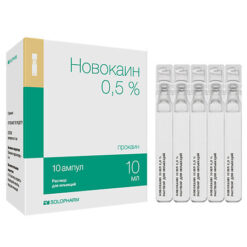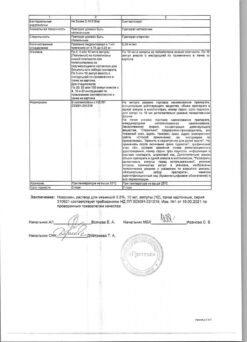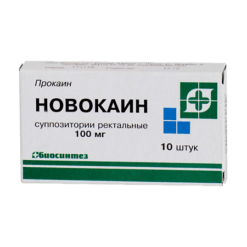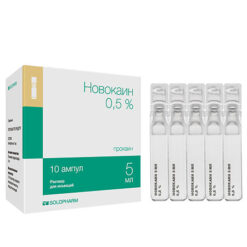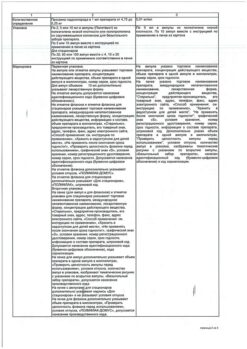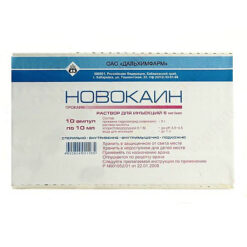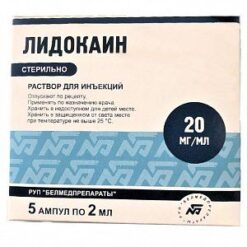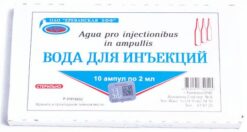No products in the cart.
Novocaine, 2.5mg/ml 400 ml
€1.00
Out of stock
(E-mail when Stock is available)
EAN: 4605453001978
SKU: 257452
Categories: Anesthesia and resuscitation, Anesthesia solutions, Medicine
Description
- infiltration, conduction and epidural anesthesia;
- vagosympathetic cervical, paranephral, circular and paravertebral blockades.
.
Active ingredient
Active ingredient
Composition
Composition
1 ml of the solution contains 2.5 mg of procaine hydrochloride as the active ingredient
auxiliary substances – 0.1 m hydrochloric acid solution,
water for injection.
How to take, the dosage
How to take, the dosage
For infiltration anesthesia: 0.25-0.5% solutions are used; for anesthesia by Vishnevsky method (taut creeping infiltration) – 0.125-0.25% solutions. To reduce absorption and prolong the action in local anesthesia, an additional 0.1% solution of epinephrine hydrochloride is given – 1 drop per 2-5-10 ml of procaine solution.
The highest doses for infiltration anesthesia for adults: the first single dose at the beginning of surgery – no more than 500 ml for 0.25% solution or 150 ml for 0.5% solution. Thereafter, during each hour of surgery – not more than 1000 ml for 0.25% solution or 400 ml for 0.5% solution.
The maximum dose for use in children over 12 years is 15 mg/kg.
For conduction anesthesia: 1-2% solutions (up to 25 ml); for epidural – 2% solution (20-25 ml). For paranephral blockade (according to A.V.Vishnevsky) 50-80 ml of 0.5% solution or 100-150 ml of 0.25% solution are injected into perinephric cell, and for vagosympathetic blockade – 30-100 ml of 0.25% solution.
For circular or paravertebral blocks 0.25% to 0.5% solution is administered intradermally.
Interaction
Interaction
It enhances the depressing effect on the central nervous system of the means for general anesthesia, sedatives and sedatives, narcotic analgesics and tranquilizers.
When using local anesthetic drugs for spinal and epidural anesthesia with guanadrel, guanethidine, mecamylamine, trimetaphane, the risk of a sharp decrease in blood pressure and bradycardia increases.
Anticoagulants (ardeparin, dalteparin, danaparoid, enoxaparin, heparin, warfarin) increase the risk of bleeding. If the injection site of the local anesthetic is treated with disinfectant solutions containing heavy metals, there is an increased risk of local reaction in the form of soreness and swelling.
The use with MAO inhibitors (furazolidone, procarbazine, selegelin) increases the risk of hypotension.
The effects of myorelaxants are enhanced and prolonged.
When procaine is administered in conjunction with narcotic analgesics, an additive effect is noted, which is used in spinal and epidural anesthesia, with increased respiratory depression.
Vasoconstrictors (epinephrine, methoxamine, phenylephrine) prolong the local anesthetic effect.
Procaine reduces the antimiasthenic effects of medications, especially when used in high doses, which requires additional correction of myasthenia gravis treatment.
Cholinesterase inhibitors (antimyasthenic JICs, cyclophosphamide, demecarine, ecothiopate, thiotepa) reduce procaine metabolism.
The metabolite of procaine (para-aminobenzoic acid) is a sulfonamide antagonist.
Special Instructions
Special Instructions
Patients require monitoring of cardiovascular, respiratory and central nervous system functions. MAO inhibitors should be withdrawn 10 days before the local anesthetic is administered.
During treatment it is necessary to refrain from driving motor transport and engaging in potentially hazardous activities requiring increased concentration and rapid psychomotor reactions.
Before use it is mandatory to test for individual sensitivity to the drug.
It should be noted that when local anesthesia is performed using the same total dose, the toxicity of novocaine is greater the more concentrated solution used. Not absorbed from mucous membranes; does not provide superficial anesthesia when applied topically.
Contraindications
Contraindications
Hypersensitivity (including to para-aminobenzoic acid and other local anesthetics), children under 12 years.
For anesthesia by creeping infiltrate method: marked fibrous changes in tissues. For epidural anesthesia: atrioventricular block, marked decrease in blood pressure, shock, infection of the lumbar puncture site, septicemia.
With caution
Emergency surgery accompanied by acute blood loss; conditions accompanied by decreased hepatic blood flow (e.g., chronic heart failure, liver disease); pseudocholinesterase deficiency; renal insufficiency; children aged 12 to 18 years and elderly patients (>65 years); frail patients; pregnancy and childbirth.
Side effects
Side effects
Headache, dizziness, somnolence, weakness, cauda equina syndrome, seizures, increased or decreased blood pressure, collapse, peripheral vasodilation, bradycardia, arrhythmia, chest pain, involuntary urination or defecation, impotence, methemoglobinemia, allergic reactions (up to and including anaphylactic shock).
Digestive system disorders: nausea, vomiting.
Others: return of pain, persistent anesthesia, hypothermia, in anesthesia in dentistry: insensitivity and paresthesia of the lips and tongue, prolongation of anesthesia.
Overdose
Overdose
Symptoms: pallor of the skin and mucous membranes.
Dizziness, nausea, vomiting, “cold” sweat, increased severity of side effects.
Treatment: maintenance of adequate pulmonary ventilation, detoxification and sympathetic therapy.
Similarities
Similarities
Additional information
| Weight | 0.714 kg |
|---|---|
| Manufacturer | Eskom NPK, Russia |
| Medication form | solution for injection |
| Brand | Eskom NPK |
Other forms…
Related products
Buy Novocaine, 2.5mg/ml 400 ml with delivery to USA, UK, Europe and over 120 other countries.


